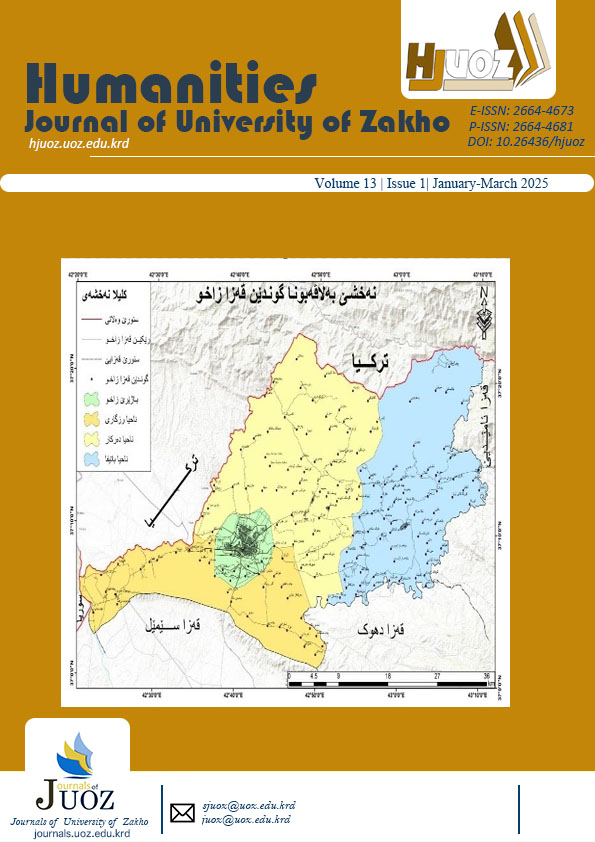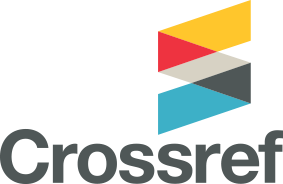INVESTIGATING SEMANTIC PROTOTYPES OF FOOD IN BAHDINI KURDISH
DOI:
https://doi.org/10.26436/hjuoz.2025.13.1.1537Keywords:
Prototype Theory, Cognitive Semantics, Category, Food, Bahdini KurdishAbstract
Prototype theory is a vital categorization theory in cognitive semantics that Rosch introduced in the 1970s. It serves as a fundamental framework in cognitive semantics for comprehending the formation and organization of categories in the human mind. The current study aims to identify the prototypes of various food categories in Bahdini Kurdish, thereby, it addresses a gap in contemporary research regarding this issue. It examines food semantics by emphasizing categorization, the most typical example in the selected category, and the impact of gender on their perception and categorization. The study investigates the prototypes of a total of nine semantic categories, including Homemade food, Fast Food, Dairy Food, Fruits, Vegetables, etc. The study has adopted descriptive and quantitative approaches by administering a questionnaire consisting of nine food categories to 100 students who speak Bahdini Kurdish based on Rosch’s model (1973, 1975). The participants are selected from English and non-English departments at the University of Zakho and comprised of an even number of 50 males and 50 females. The findings identified nine food categories in Bahdini Kurdish, which feature representative or the best examples such as rice and dolma for Homemade food, pizza for fast food, baklava for sweets, etc. Gender-based disparities arose, as males and females had distinct preferences within these categories.
Downloads
References
Abdullah, A. & Salih, S (2017). The use of prototype theory in the Kurdish languages. Humanities Journal of University of Zakho (HJUOZ), 5(2), 258–271. https://doi.org/10.26436/2017.5.2.310
Coleman, L., & Kay, P. (1981). Prototype semantics: The English word lie. Language, 57(1), 26–44. https://doi.org/10.1353/lan.1981.0002
Croft, W. & Cruse, D. A. (2004). Cognitive Linguistics. Cambridge: Cambridge University Press. https://doi.org/10.1017/cbo9780511803864
Evans, V. & Green, M. (2006). Cognitive linguistics: An introduction. GB: Edinburgh University Press. http://www.gbv.de/dms/bs/toc/50769533x.pdf
Fauconnier, G. (1985). Mental spaces: Aspects of meaning construction in natural language. Cambridge, MA: MIT Press. https://psycnet.apa.org/record/1994-98635-000
Foroni, F., & Rumiati, R. I. (2017). Food perception and categorization: From food/no-food to different types of food. In Handbook of categorization in cognitive science (pp. 271-287). Elsevier. https://doi.org/10.1016/B978-0-08-101107-2.00012-9
Fromkin, V. & Rodman, R. (1988). An Introduction to Language. 3rd ed. USA: CBS College Publishing. https://books.google.iq/books/about/An_Introduction_to_Language.html?id=AkwFgEx3QBgC&redir_esc=y
Gärdenfors, P. (1999). Some tenets of cognitive semantics. In Pragmatics & beyond. New series (p. 19). https://doi.org/10.1075/pbns.55.03gar
Geeraerts, D. (2010). Theories of lexical semantics. https://doi.org/10.1093/acprof:oso/9780198700302.001.0001
Giannakopoulou, A. (2003). Prototype theory: An evaluation. ECLOGA Working Papers, 3. http://hdl.handle.net/10547/625850
Jackendoff, R. (1983). Semantics and cognition. Cambridge, MA: MIT Press. https://psycnet.apa.org/record/1985-98223-000
Jamalifar, G. (2014). The conceptualization of fruit/vegetable distinction in Farsi and American English: A contrastive pragmatic approach. Procedia-Social and Behavioral Sciences, 98, 764–769. https://doi.org/10.1016/j.sbspro.2014.03.479
Jumaniyozovna, B. N. (2023). Prototype theory in cognitive linguistics. In Integration Conference on Integration of Pragmalinguistics, Functional Translation Studies and Language Teaching Processes (pp. 72-74). https://www.conferenceseries.info/index.php/online/article/download/967/873
Khollam, P., & Mane, P. (2019). Review on food categorization techniques in machine learning. Int. J. Res. Anal. Rev, 6, 107-111. http://ijrar.com/upload_issue/ijrar_issue_20543700.pdf
LaBar, K. S., Gitelman, D. R., Parrish, T. B., Kim, Y. H., Nobre, A. C., & Mesulam, M. M. (2001). Hunger selectively modulates corticolimbic activation to food stimuli in humans. Behavioral Neuroscience, 115(2), 493–500. https://doi.org/10.1037/0735-7044.115.2.493
Lakoff, G. (1987). Women, fire, and dangerous things: What categories reveal about the mind. Chicago/London: The University of Chicago Press. http://books.google.ie/books?id=9GxmrgEACAAJ&dq=Women,+fire,+and+dangerous+things:+What+categories+reveal+about+the+mind&hl=&cd=3&source=gbs_api
Langacker, R. (1987). Foundations of cognitive grammar: Volume I: Theoretical prerequisites. Stanford, CA: Stanford University Press. https://books.google.iq/books/about/Foundations_of_Cognitive_Grammar.html?id=g4NCRFbZkZYC&redir_esc=y
Lyons, J. (1981). Language and linguistics. GB: Cambridge University Press. https://doi.org/10.1017/cbo9780511809859
Palmer, R. F. (1981). Semantics (2nd ed). Cambridge: Cambridge University Press. https://books.google.iq/books/about/Semantics.html?id=UWJSaxH9GiMC&redir_esc=y
Parker, F. (1986). Linguistics for non-linguists. London: Taylor & Francis. https://books.google.iq/books/about/Linguistics_for_Non_linguists.html?id=s7lrAAAAIAAJ&redir_esc=y
Radden, G., & Dirven, R. (2007). Cognitive English grammar. In Cognitive linguistics in practice CLiP. USA: John Benjamins Publishing Company. https://doi.org/10.1075/clip.2
Rosch, E. (1973). On the internal structure of perceptual and semantic categories. Cognitive Development and the Acquisition of Language/New York: Academic Press, (pp. 111–144). https://doi.org/10.1016/B978-0-12-505850-6.50010-4
Rosch, E. (1975). Cognitive representations of semantic categories. Journal of Experimental Psychology General, 104(3), 192–233. https://doi.org/10.1037/0096-3445.104.3.192
Rosch, E., & Lloyd, B. B. (1978). Cognition and categorization. Lawrence Erlbaum Associates. https://www.cs.rice.edu/~vo9/recognition/2016/slides/lecture07/CognitionAndCategorization.pdf
Rosch, E., Mervis, C. B., Gray, W. D., Johnson, D. M., & Boyes-Braem, P. (1976). Basic objects in natural categories. Cognitive Psychology, 8(3), 382–439. https://doi.org/10.1016/0010-0285(76)90013-x
Schwanenflugel, P. J., & Rey, M. (1986). The relationship between category typicality and concept familiarity: Evidence from Spanish- and English-speaking monolinguals. Memory & Cognition, 14(2), 150–163. https://doi.org/10.3758/bf03198375
Sweetser, E. (1990). From etymology to pragmatics. Cambridge: Cambridge University Press. https://doi.org/10.1017/cbo9780511620904
Talmy, L. (1988). Force dynamics in language and cognition. Cognitive Science, 12(1), 49–100. https://doi.org/10.1207/s15516709cog1201_2
Talmy, L. (2000). Toward a cognitive semantics, volume 2: Typology and process in concept structuring. In The MIT Press eBooks. https://doi.org/10.7551/mitpress/6848.001.0001
United States Department of Agriculture. (2017). Back to basics: All about myplate food groups. https://www.usda.gov/media/blog/2017/09/26/back-basics-all-about-myplate-food-groups
University of Nebraska-Lincoln. (2022). What are the five food groups? https://food.unl.edu/article/food-groups
Yule, G. (2006). The study of language. 3rd ed. Cambridge: Cambridge University Press. https://books.google.iq/books/about/The_Study_of_Language.html?id=Zw5Y0o0q1bYC&redir_esc=y
Yule, G. (2014). The study of language. Cambridge University Press. https://books.google.iq/books/about/The_Study_of_Language.html?id=x-WfAgAAQBAJ&redir_esc=y
Published
How to Cite
Issue
Section
License
Copyright (c) 2025 Edwardo Kh. Dinkha, Fakhir O. Mohammed

This work is licensed under a Creative Commons Attribution-NonCommercial-ShareAlike 4.0 International License.
Authors who publish with this journal agree to the following terms:
- Authors retain copyright and grant the journal right of first publication with the work simultaneously licensed under a Creative Commons Attribution License [CC BY-NC-SA 4.0] that allows others to share the work with an acknowledgment of the work's authorship and initial publication in this journal.
- Authors are able to enter into separate, additional contractual arrangements for the non-exclusive distribution of the journal's published version of the work, with an acknowledgment of its initial publication in this journal.
- Authors are permitted and encouraged to post their work online.

















